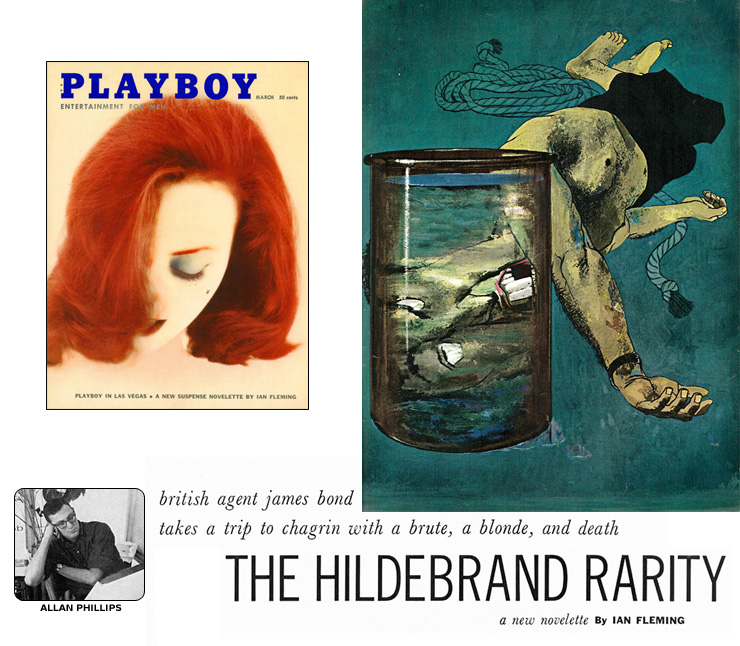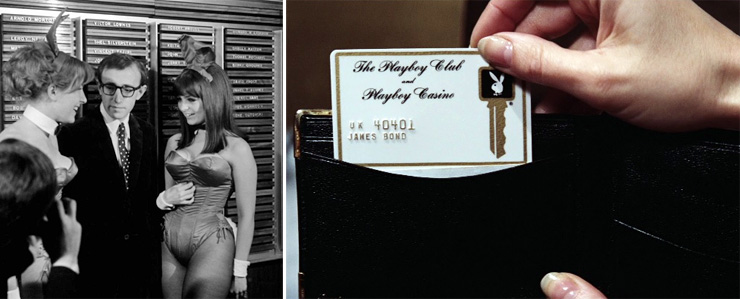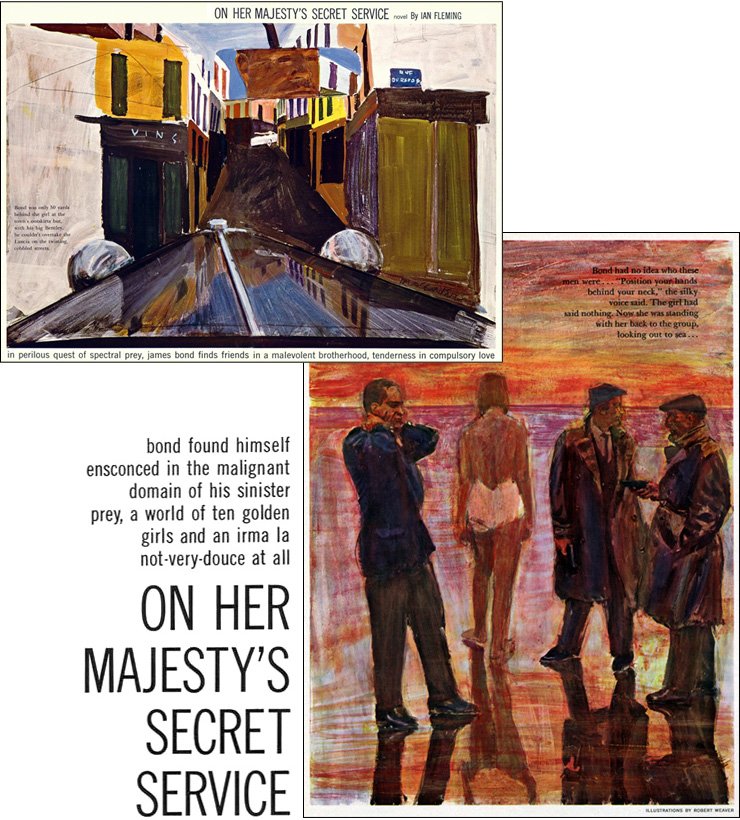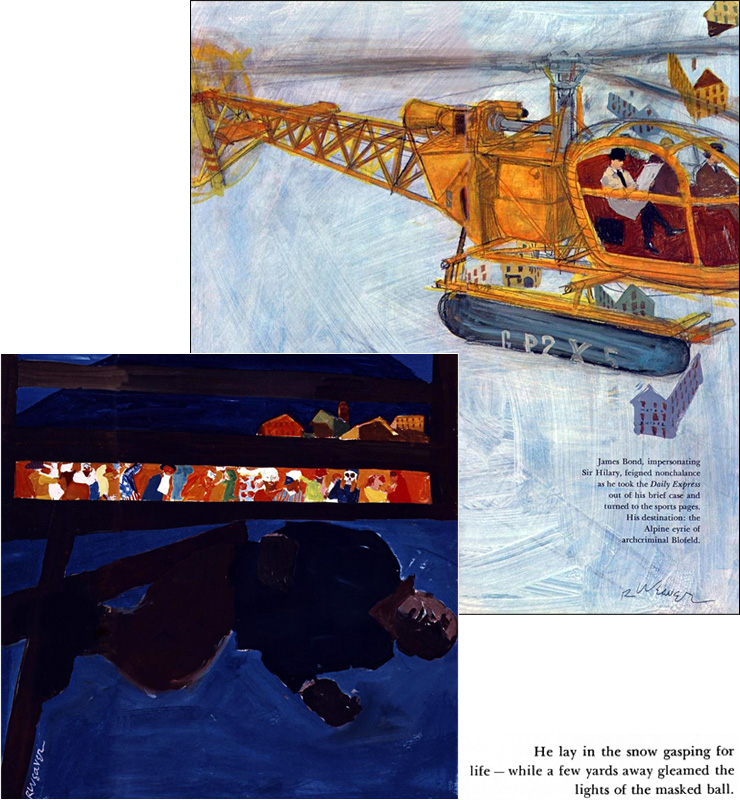|
|
JAMES BOND
|
|
|
JAMES BOND
|
|
||
|
||
|
Founded in Chicago in 1953 by Hugh Hefner (1926-2017), PLAYBOY is an American lifestyle and entertainment magazine famous for its centre-folds and pictorials of nude and semi-nude women (from March 2016 the printed version of the magazine no longer featured full-frontal nudity, although this returned in the March/April 2017 issue when PLAYBOY became a bi-monthly publication). Alongside interviews with well-known public figures, PLAYBOY also has a long history of publishing short stories and novels by some of the world's most notable writers. Ian Fleming's 1959 short story THE HILDEBRAND RARITY was first published in the March 1960 issue of PLAYBOY accompanied by a superb illustration by artist Allan Phillips. The story was then published in the UK on April 11, 1960 by Jonathan Cape as part of the FOR YOUR EYES ONLY anthology. The US edition was published by Viking Press in August of the same year. The March 1960 issue of PLAYBOY therefore contains the first printed publication of THE HILDEBRAND RARITY, a month ahead of its UK hardcover debut. At this time PLAYBOY was not as widely available outside the USA, and only obtainable via selected outlets and newsstands in the UK, or via subscription. |
||
 |
||
|
By the mid-1960s PLAYBOY, and it's ubiquitous bunny logo designed by Art Paul (1925-2018), had become a global brand and also operated exclusive clubs across the USA, and selected cities worldwide. The first PLAYBOY Club opened in Chicago in 1960, with the London club opening on June 30, 1966, made possible following the legalization of gambling in the UK on January 1, 1961. Situated at 45 Park Lane, overlooking Hyde park in London's Mayfair, the PLAYBOY Club rapidly became the largest and most successful casino in Europe. In its heyday in the 60s and 70s Hugh Hefner's London club was visited by the rich and famous, along with some of the biggest names in showbusiness including Sean Connery, Joan Collins, Roger Moore, and influential critic and writer Kenneth Tynan. PLAYBOY founder Hugh Hefner recalled: “When we opened the [London] club in 1966, there were three or four major Hollywood films being made in London... Ursula Andress was there with Jean-Paul Belmondo, Peter Sellers came; Woody Allen got up and performed.” All four actors were then in London filming Casino Royale (1967). Costing $25 per year for membership, access to the club was via a bunny-headed metal key (and later a credit card sized metal key-card). PLAYBOY Club membership became a status symbol, although only 21% of all key holders actually ever set foot inside one of the clubs. |
||
 |
||
|
The March 1960 issue of PLAYBOY is also notable for having a pictorial featuring Jill St. John who, just over a decade later, would star in as Tiffany Case in Diamonds Are Forever - becoming the first American actress to play a Bond girl. She also appeared in the December 1971 issue of PLAYBOY featuring her co-star Sean Connery in a pictorial alongside Lana Wood (playing Plenty O'Toole), who was willing to shed a little more clothing than Miss St. John. In the film Diamonds Are Forever (1971) in order to confuse his contact Tiffany Case, Bond replaces his wallet with that of diamond smuggler Peter Franks (Joe Robinson) who he has just killed. When Tiffany Case opens the wallet she finds Bond's PLAYBOY Club membership card resulting in the classic exchange: “You've just killed James Bond!”, to which Bond replies “Is that who it was? Just goes to show nobody is indestructible.” |
||
|
|
||
|
PLAYBOY became the first magazine to serialize a James Bond novel when ON HER MAJESTY'S SECRET SERVICE appeared in the April 1963 issue. The hardback first edition of the novel was published in the UK by Jonathan Cape in the same month. The story was illustrated by Robert Weaver (1924-1994) who was the brother of noted actor Fritz Weaver (1926-2016). The first of three instalments featured a double-page illustration of James Bond reflected in the rear-view mirror of his Bentley as he follows Tracy's Lancia through the narrow streets of Royale-Les-Eaux. |
||
 |
||
|
||
|
Despite Fleming's detailed description, Weaver's version of James Bond still looks suspiciously like Sean Connery - whose first film as 007 would be released in the United States the following month. Weaver's second full-page illustration in the April 1963 issue [pictured above] was given a citation for merit by the New York Society of Illustrators in 1964. The original artwork was sold for $2,629 in December 2003 as part of CHRISTIE'S ‘PLAYBOY at 50’ auction in New York. |
||
 |